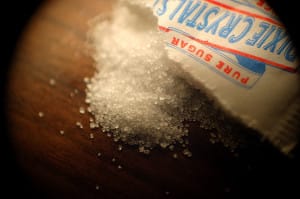Sugar isn’t healthy, but some sweeteners may be worse than others—especially when you don’t realize they’re in your food.
Rodale News
by Julia Westbrook
 |
When you say that you’re ready to cut out sugar, you’ll have to dig a little deeper than just taking your coffee unsweetened. Table sugar isn’t the only public enemy number one: Fructose is, too, according to research published in The Journal of Nutrition.
Let’s be clear here: We’re not saying that your table sugar, or sucrose, is health food. Far from it. Around 44 percent of the added sugar in the American diet is sucrose, according to the researchers at the University of Utah. They also discovered that high-fructose corn syrup (HFCS), which makes up 42 percent of the added sugar in the American diet, may be more toxic than standard table sugar.
The researchers fed mice a diet with the same proportion of sugar (25 percent of their calories), in the form of either table sugar or HFCS, as in the average human diet. They found that the mice eating HFCS had had 26 percent fewer offspring and nearly twice the death rate as mice fed a sucrose diet.
How did so much HFCS get into our diets in the first place? It started in the 1970s with the low-fat fad. As people shouted the mantra “eat fat, gain fat,” food manufactures gave them what they wanted: low-fat food. Anne Alexander, author of The Sugar Smart Diet, says, “These products may have contained little or no fat, but many did contain sugar. Lots of it.” More specifically, they were made with lots of high-fructose corn syrup.
HFCS was developed by researchers who wanted replace expensive cane sugar with a cheap sweetener made from corn. “As high-fructose corn syrup became cheaper to make, food manufacturers began to add it to everything,” says Alexander; “not just soda, but jarred sauces, canned soups, crackers, and prepared foods.”
Wayne Potts, PhD, professor of Biology at the University of Utah and senior author of the study says, “We speculate that the different sugars could favor different microbes in the guts of mice. Other research has shown differences in bacterial communities in the gut to be associated with metabolic diseases in rodents and in humans. It’s possible one form of sugar causes more bacteria to get across your gut than another.”
With more than 38 names for sugar, a good place to start when you’re ready to ditch the sweet stuff is with HFCS. No, you won’t be getting them all, but if you’re new to reading labels, it’s your first baby step to freedom from sugar. Some foods notoriously high in sugar include yogurt, barbecue sauce, ketchup, salad dressings, and granola bars.

